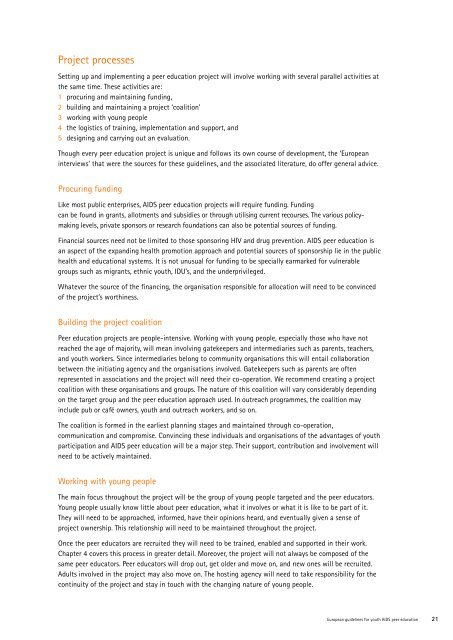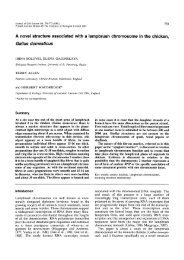European guidelines for youth AIDS peer education - University of ...
European guidelines for youth AIDS peer education - University of ...
European guidelines for youth AIDS peer education - University of ...
- No tags were found...
Create successful ePaper yourself
Turn your PDF publications into a flip-book with our unique Google optimized e-Paper software.
Project processesSetting up and implementing a <strong>peer</strong> <strong>education</strong> project will involve working with several parallel activities atthe same time. These activities are:1 procuring and maintaining funding,2 building and maintaining a project ‘coalition’3 working with young people4 the logistics <strong>of</strong> training, implementation and support, and5 designing and carrying out an evaluation.Though every <strong>peer</strong> <strong>education</strong> project is unique and follows its own course <strong>of</strong> development, the ‘<strong>European</strong>interviews’ that were the sources <strong>for</strong> these <strong>guidelines</strong>, and the associated literature, do <strong>of</strong>fer general advice.Procuring fundingLike most public enterprises, <strong>AIDS</strong> <strong>peer</strong> <strong>education</strong> projects will require funding. Fundingcan be found in grants, allotments and subsidies or through utilising current recourses. The various policymakinglevels, private sponsors or research foundations can also be potential sources <strong>of</strong> funding.Financial sources need not be limited to those sponsoring HIV and drug prevention. <strong>AIDS</strong> <strong>peer</strong> <strong>education</strong> isan aspect <strong>of</strong> the expanding health promotion approach and potential sources <strong>of</strong> sponsorship lie in the publichealth and <strong>education</strong>al systems. It is not unusual <strong>for</strong> funding to be specially earmarked <strong>for</strong> vulnerablegroups such as migrants, ethnic <strong>youth</strong>, IDU’s, and the underprivileged.Whatever the source <strong>of</strong> the financing, the organisation responsible <strong>for</strong> allocation will need to be convinced<strong>of</strong> the project’s worthiness.Building the project coalitionPeer <strong>education</strong> projects are people-intensive. Working with young people, especially those who have notreached the age <strong>of</strong> majority, will mean involving gatekeepers and intermediaries such as parents, teachers,and <strong>youth</strong> workers. Since intermediaries belong to community organisations this will entail collaborationbetween the initiating agency and the organisations involved. Gatekeepers such as parents are <strong>of</strong>tenrepresented in associations and the project will need their co-operation. We recommend creating a projectcoalition with these organisations and groups. The nature <strong>of</strong> this coalition will vary considerably dependingon the target group and the <strong>peer</strong> <strong>education</strong> approach used. In outreach programmes, the coalition mayinclude pub or café owners, <strong>youth</strong> and outreach workers, and so on.The coalition is <strong>for</strong>med in the earliest planning stages and maintained through co-operation,communication and compromise. Convincing these individuals and organisations <strong>of</strong> the advantages <strong>of</strong> <strong>youth</strong>participation and <strong>AIDS</strong> <strong>peer</strong> <strong>education</strong> will be a major step. Their support, contribution and involvement willneed to be actively maintained.Working with young peopleThe main focus throughout the project will be the group <strong>of</strong> young people targeted and the <strong>peer</strong> educators.Young people usually know little about <strong>peer</strong> <strong>education</strong>, what it involves or what it is like to be part <strong>of</strong> it.They will need to be approached, in<strong>for</strong>med, have their opinions heard, and eventually given a sense <strong>of</strong>project ownership. This relationship will need to be maintained throughout the project.Once the <strong>peer</strong> educators are recruited they will need to be trained, enabled and supported in their work.Chapter 4 covers this process in greater detail. Moreover, the project will not always be composed <strong>of</strong> thesame <strong>peer</strong> educators. Peer educators will drop out, get older and move on, and new ones will be recruited.Adults involved in the project may also move on. The hosting agency will need to take responsibility <strong>for</strong> thecontinuity <strong>of</strong> the project and stay in touch with the changing nature <strong>of</strong> young people.<strong>European</strong> <strong>guidelines</strong> <strong>for</strong> <strong>youth</strong> <strong>AIDS</strong> <strong>peer</strong> <strong>education</strong> 21
















